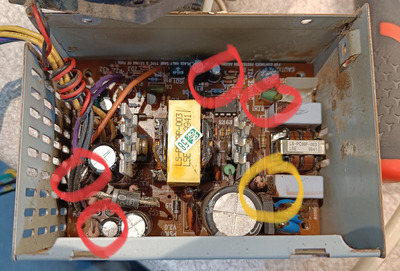First post, by justin1985
I'm always a sucker for a super compact retro PC, and managed to pick up one of the PCChips "BookPC" systems very cheaply "untested" on eBay. It was absolutely filthy, but turns out that while the PSU is dead, the motherboard only needed a new coin cell and contact cleaner on the DIMM slot. With a normal PSU lashed up to the proprietary pin-out it boots nicely! It's got a Celeron 400Mhz with just 32Mb SDRAM. I'm hoping to make a nice dedicated tiny DOS / Win3.11 system with it.
It has a totally dead PSU though, and they seem totally proprietary in these machines ... There is no life at all when powered on with green pin shorted, and the purple standby wire tests as short to ground. The brown goop has gone crusty, but it definitely isn't conductive.
I've done some thorough checking (daylight helped) and found several components blown or visibly damaged. 1000uf 10v and 1000uf 16v capacitors towards the left (output) side of the board are blown (the latter totally popped and had actually desoldered itself!).
Towards the input side a there was a clear scorch mark on the casing under a PCB cutout (yellow circle), and I initially suspected the big white mains capacitor or the bridge rectifier, but close up neither have any sign of damage. The resistor is crumbly at one end, but does still have its 120K resistance. So maybe that was just smoke/heat from one of the caps escaping through one of the empty holes? There is also a crumbling green thermistor near the input, and at least two cracked ceramic disc capacitors (one on the back).
I checked the diodes and transistors as best I could, but didn't find any unexpected shorts on them.
So as the PSU is pretty well unique, is it worth ordering replacement parts for all the capacitors and other visibly damaged things to give it a shot at repairing it? (comes to about £30 worth of parts and £40 minimum order at Farnell).
Would a PicoPSU be the only other realistic option?
(interestingly, despite the blown caps in the PSU, no sign of bulging caps on the motherboard!)

